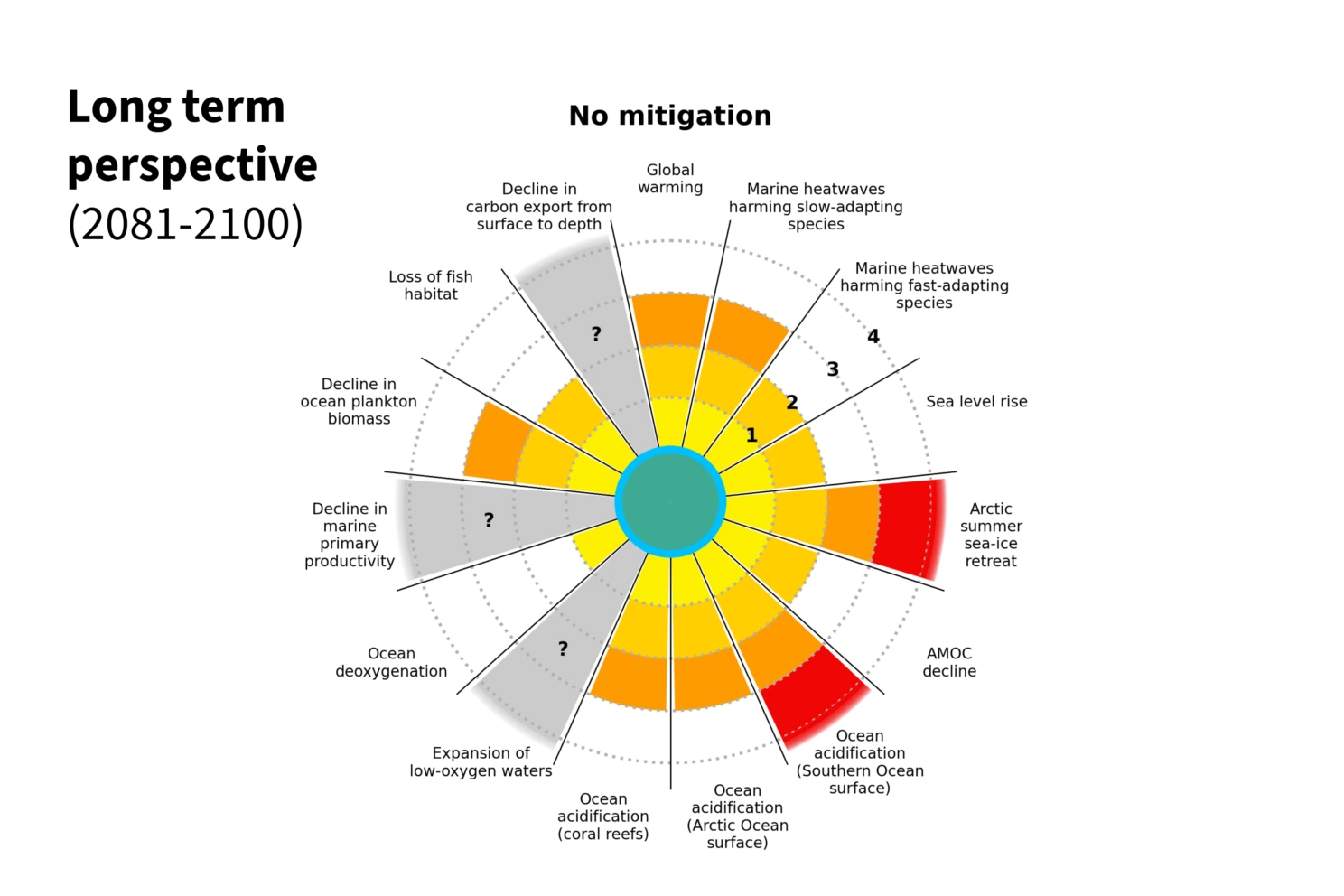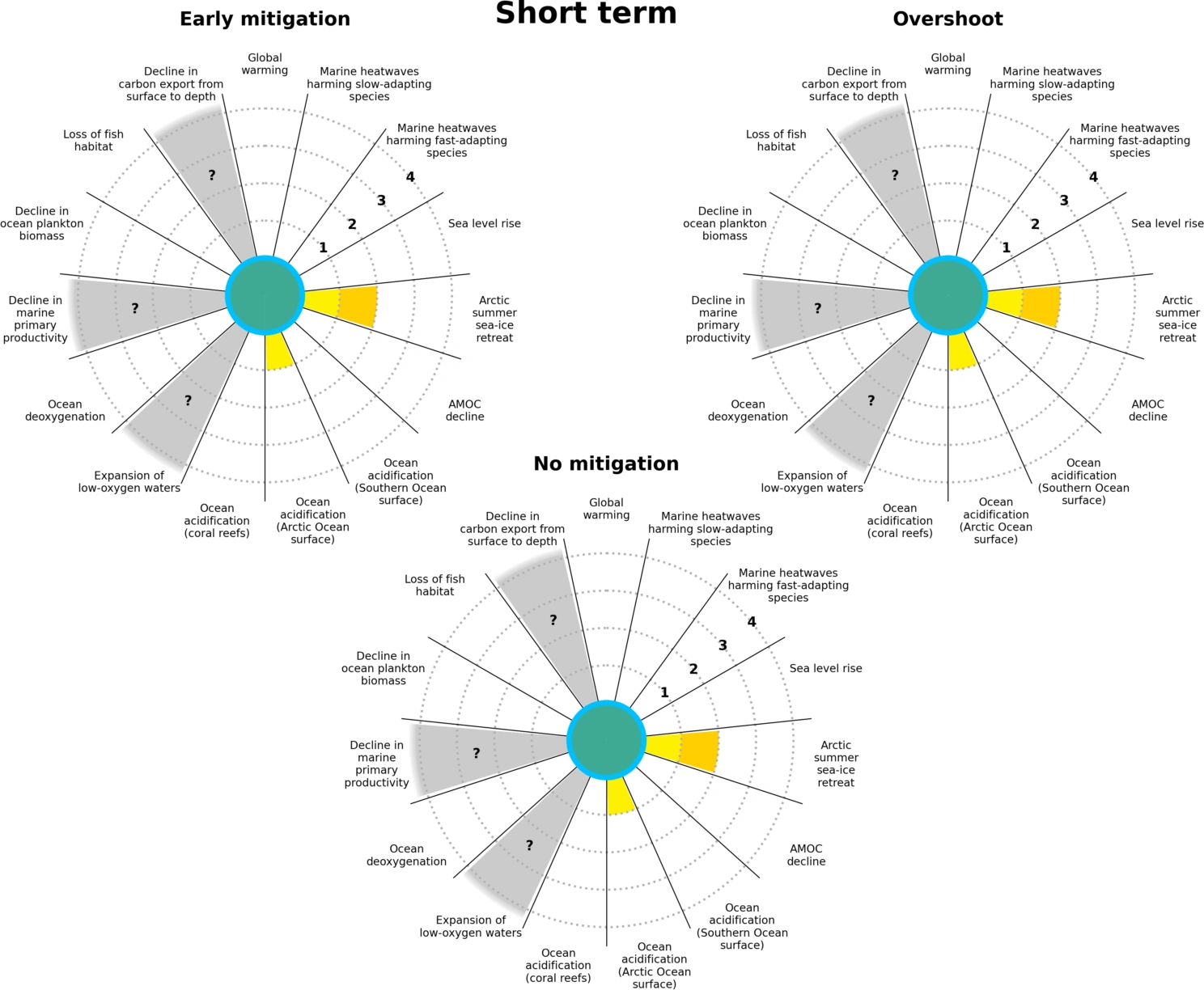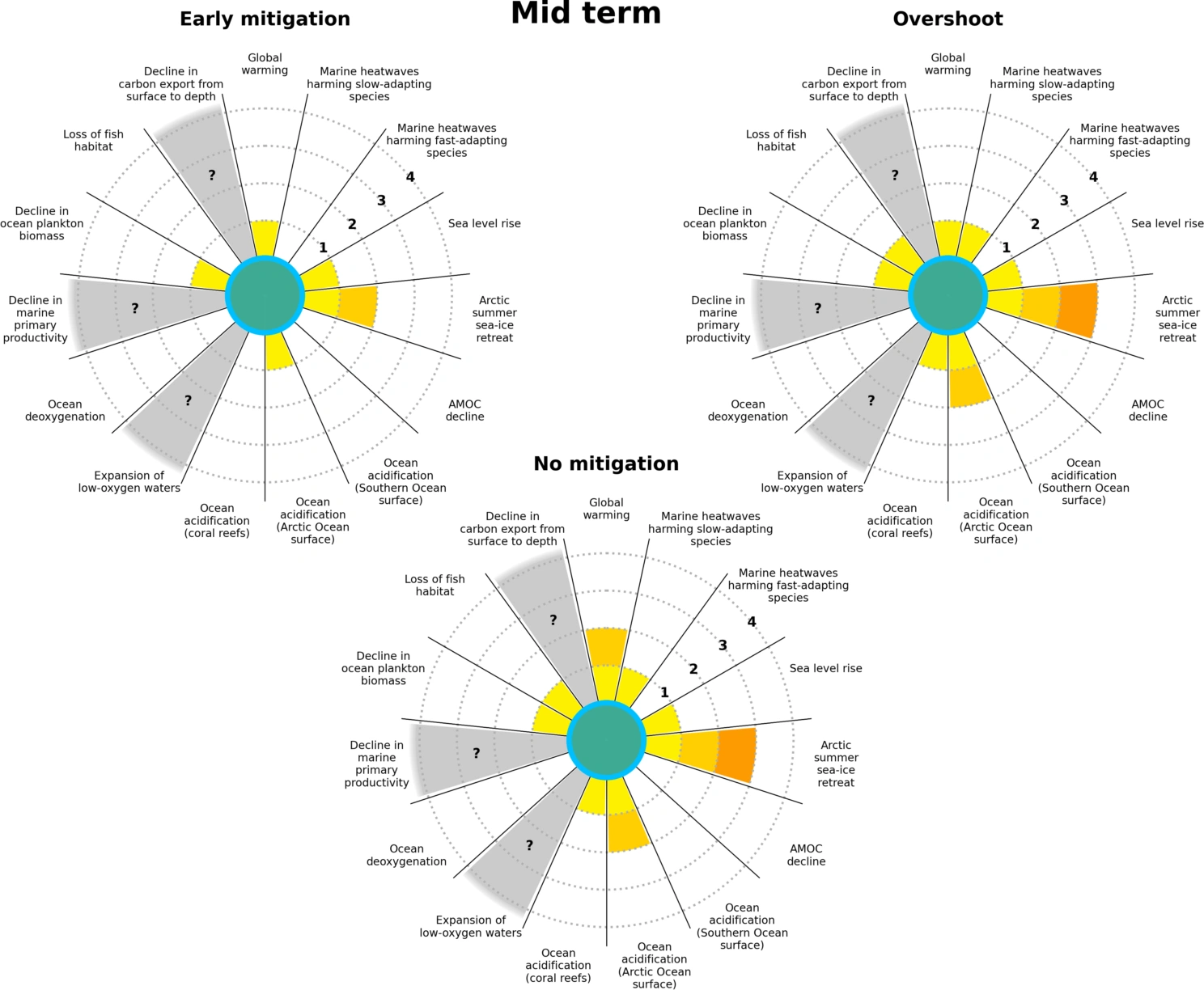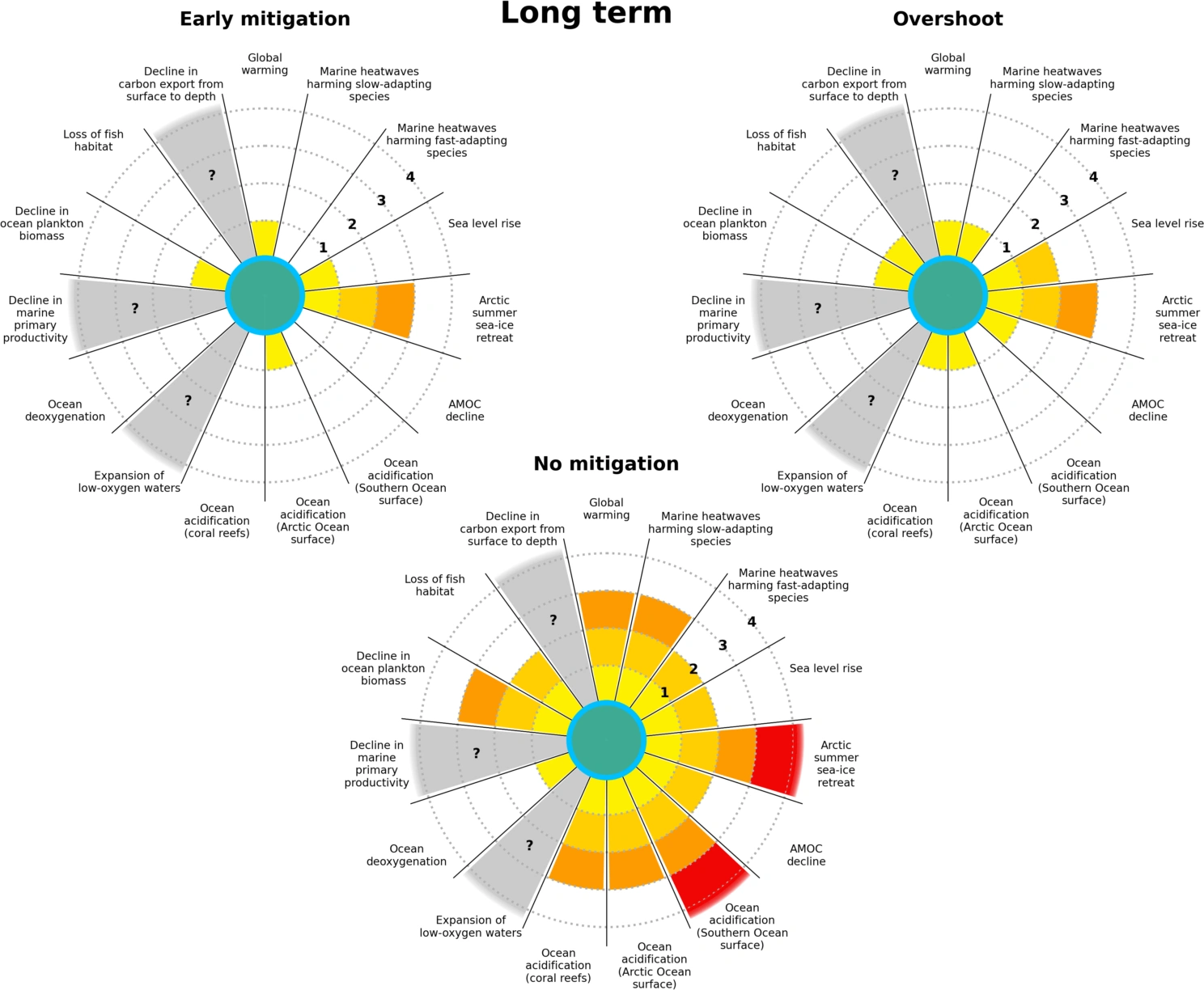Mapping the comfort zone of ocean life
What is the safe operating space of marine ecosystems? In a new paper, Timothée Bourgeois and colleagues investigate the limits of marine ecosystems to preserve of biodiversity, food security, biodiversity and risk for human societies.
Publisert 29. October 2025

The model experiment in a perspective from 2081-2100, here in the no-mitigation-scenario. The study shows a clear difference with or without climate mitigations. Figure: Jean Negrel
– The Ocean is changing at an alarming pace, and our efforts to mitigate climate change are still insufficient, says Timothée Bourgeois, researcher at NORCE Research and the Bjerknes Centre for Climate Research.
Together with an international group of researchers in the European COMFORT project, they have mapped the safe operating space of marine ecosystems and explored how it evolved under three contrasting futures.
The Ocean is undergoing unprecedented change due to greenhouse gas emissions, leading to global warming and ocean acidification.
“Such changes, either progressive or abrupt, pose a threat to biodiversity, food security and human societies. However, it remains notoriously difficult to determine exact limits of a “safe operating space for humanity” the publication reports (link).
Fifteen ocean indicators
By exploiting simulations in a variety of Earth system models, Bourgeois and colleagues have investigated the response of fifteen ocean indicators to future emissions:
Indicators
- Global warming
- Marine heatwaves harming slow-adapting species
- Marine heatwaves harming fast-adapting species
- Sea level rise
- Arctic summer sea-ice retreat
- Decline in the Atlantic Meridional Ocean Circulation (AMOC)
- Ocean acidification (Southern Ocean surface)
- Ocean acidification (Arctic Ocean surface)
- Ocean acidification (tailored to coral reef needs)
- Expansion of low-oxygen waters
- Ocean deoxygenation – lower levels of oxygen challenges marine life
- Decline in marine primary productivity – the basis of the marine food chain.
- Decline in ocean plankton biomass
- Loss of fish habitat
- Decline in carbon export from surface to depth
The fifteen ocean indicators are designed to characterize impacts on the marine environment in a broad context from marine heatwaves, AMOC, carbon export from the surface to the deep, fish habitat, ocean acidification, and deoxygenation.
Three scenarios for future emissions
To estimate timing and warming levels at which ocean indicators exceed four limits of different severity, the researchers explored simulations of three future emission scenarios: Two scenarios with climate mitigation strategies, and one high-emissions scenario with no climate mitigation.
Under high emissions, the strongest severity of impacts is reached with high probability for:
- Marine heatwaves duration
- Arctic summer sea-ice retreat
- Ocean acidification
- Decline in ocean plankton biomass

Until 2040: In a short term perspective, the figure show results in three scenarios for the period 2021-2040.
Experiments in three future emission pathways, including two with climate mitigation strategies, where one is a scenario with a pronounced overshoot.
An overshoot scenario is a scenario where the mean global temperature temporarily exceeds a certain limit for a period and then falls back below this limit, such as 1.5°C or 2°C as in the Paris Agreement.
The third model experiment follows a high emission scenario with no climate mitigation.
– The good news is that ambitious mitigation strategies lead to clear benefits compared to results without mitigation, Bourgeois points out. For example, we can see that the impact on ocean acidification is less severe in certain large regions, such as the Southern Ocean and the Arctic, but also globally, because of ambitious mitigation.

Until 2060: Results in a mid term perspective, simulated for the period 2040-2060. The results are better with climate mitigation. Figure: Jean Negrel, NORCE

Long term: Results from 2081-2100 shows a clear benefits of climate mitigation.
Figure: Jean Negrel, NORCE
Swimming out of the comfort zone
Together, the indicators reflect how changes in the Ocean occur both at the surface and at depth in multiple ways—physically, chemically, biologically. Marine organisms struggle to adapt to the unmatched pace of these changes, which ultimately threaten marine ecosystems. These ecosystems, in turn, provide services to our societies, like fisheries and aquaculture, coastal protection, carbon sequestration, and provision of materials for medicines.
– We need to preserve marine ecosystems and today’s choices from human societies will determine their fate. Therefore, we have applied the concept of safe operating space for marine ecosystems, with the aim of exploring how these multiple changes evolve coherently in different futures, Bourgeois says.
However, the scientific community still debates what constitutes a “safe operating space for marine ecosystems” and seeks to define relevant thresholds that if crossed, would lead to irreversible change. Bourgeois' study helps move this discussion forward.

– The good news is that ambitious mitigation strategies lead to clear benefits compared to results without mitigation, Timothée Bourgeois points at. Photo: Amandine Maillard
Ocean tipping points in uncharted waters
Despite many unknowns, what is clear is that greenhouse‑gas emissions are driving changes in the Ocean through both global warming and ocean acidification.
These changes will generally intensify as atmospheric CO₂ concentrations rise, but abrupt shifts are also possible, leaving ecosystems little time to adapt. Such abrupt shifts are often associated with tipping points—critical thresholds beyond which the system can transition irreversibly from one state to another.
Large uncertainties remain about the location and likelihood of tipping points in the Ocean.
Bourgeois has for a long time studied marine biogeochemistry with models. Now, when leading the work on the safe operating space of marine ecosystems in a broader frame, he has become more worried.
– As many ocean and climate scientists, I am aware of the dramatic current state of the Ocean. However, leading such an exhaustive study on a day-to-day basis can be a mental burden when constantly seeing the broader picture, says Timothée Bourgeois.
References
Bourgeois, T., Tran, G. T., Jeltsch-Thömmes, A., Schwinger, J., Fröb, F., Frölicher, T. L., Blenckner, T., Torres, O., Negrel, J., Keller, D. P., Oschlies, A., Bopp, L., and Joos, F.: Mapping the safe operating space of marine ecosystems under contrasting